On March 5, 2024, Google announced the launch of the March 2024 Core Update. The update is without doubt, one of the most significant SEO events of 2024. This is due to a variety of reasons related to the nature of the rollout, its relationship to the Helpful Content Update, the unique statements coming out of Google, the current state of the web, and more.
Today we announced the March 2024 core update & new spam policies that, in combination, are designed to show less content made to attract clicks and more content that people find useful. Learn more: https://t.co/wQVZ8mExRB
— Google Search Central (@googlesearchc) March 5, 2024
Let’s get into a bit on what happened with the March 2024 Core Update and what it means for websites and SEOs.
The March 2024 Core Update: Summary of Events
The typical core update takes about two or so weeks to fully roll out. In contrast, the March 2024 Core Update took 45 days to complete.
As you can see below, there were many peaks in rank volatility as the update progressed:
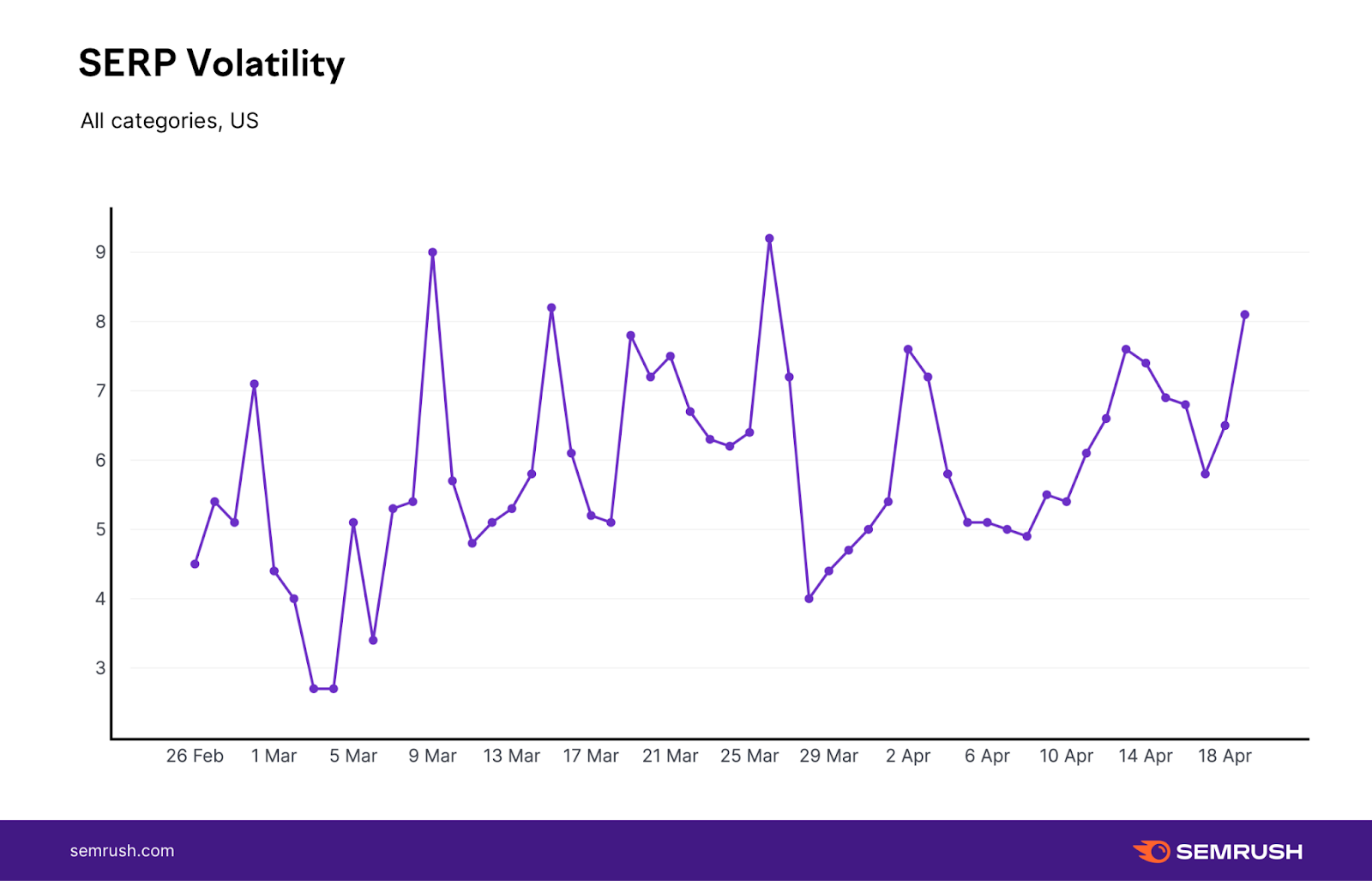
This often meant sites underwent a series of ranking reversals over the course of the update.
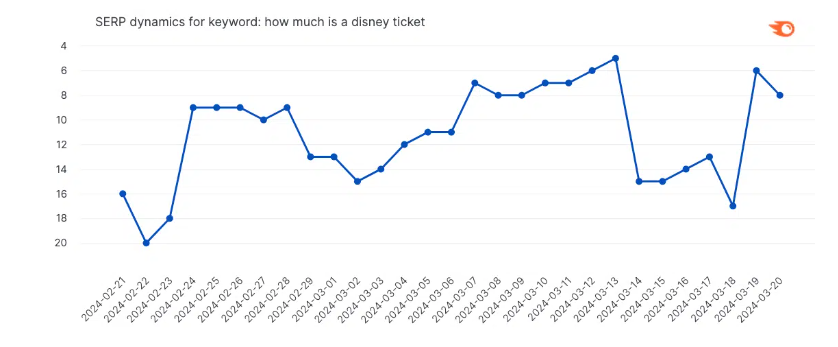
A URL showing a stark ranking reversal during the March 2024 Core Update
This put many SEOs in a state of flux for the better part of six weeks. There was often no way to know where the rankings would ultimately end up by the time the update completed itself.
The 45-day rollout, and the rollercoaster ride sites and SEOs underwent, speaks to the uniqueness of the March 2024 Core Update.
The Underlying Purpose of the March 2024 Core Update
There are a variety of things that make the March 2024 Core Update different from other core updates. To start, Google usually makes an announcement across social media via their Search Central account, and/or via their Search Liaison, Danny Sullivan.
With the March 2024 Core Update, they also released an entire blog post related to the purpose of the update. Personally, I find it interesting and significant that the post wasn’t written by a Search Advocate, or another forward-facing Google employee, but written by their Director of Product, Elizabeth Tucker.
To me, this goes to Google looking to address some of the optics and perception issues it currently faces. More on this later.
In the blog post, Tucker references the work started with the Helpful Content Update (HCU) in 2022 and states “We’re bringing what we learned from that work into the March 2024 core update.”
Meaning, Google’s drive to find “helpful” results and rank them is no longer the responsibility of the HCU, but of the core algorithm itself.
This “incorporation” resulted in the March 2024 Core Update being, as Google said “a more complex update than our usual core updates, involving changes to multiple core systems. It also marks an evolution in how we identify the helpfulness of content.”
Specifically, Google has said they have moved away from “one system” to determine helpfulness and now use the core algorithm to “use a variety of signals and systems” to make that assessment.
There’s been a lot of conversation within the SEO community as to what this all means. My personal take, as I’ve discussed at greater length before, is that the new multifaceted way of approaching helpfulness is built off the foundation of the HCU. It’s not that the HCU was discarded, but rather improved upon and expanded.
This would mean that at its root, the current way of assessing helpfulness within the Google algorithm is founded on the HCU. While Google has at times tried to create distance between the core algorithm and the HCU, I still think they are connected in the same way that the process for building a Ford Model T is still fundamentally used all these years later. The distinction here is that both processes, in determining helpfulness, while different and unique, are definitively distinct in essence. Again, this is just my take.
The net outcome of all this complexity is the aforementioned 45-day rollout. On April 26, we were informed that the March 2024 Core Update had been completed on April 19. Why was there a week’s delay in letting us know? Your guess is as good as mine and it’s just one more thing that makes the March 2024 Core Update distinct when compared to other core updates.
Google’s Concurrent Spam Updates
Another distinctive factor with the March 2024 Core Update is the overlap between itself and various changes to its spam policies. At the same time that the March 2024 Core Update was announced, Google also released a spam update.
The update focused on:
- Expired domain abuse
- Scaled content abuse
With the latter, Google implemented a voluminous amount of manual actions.
Google also stated that beginning on May 5, 2024, a new policy targeting “site reputation abuse” (more commonly known as Parasite SEO) would be going into effect.
The State of SERP In Relation to the March 2024 Core Update
According to Tucker, the updates to the spam policies, along with the March 2024 Core Update, were expected to reduce unhelpful content on the SERP by 40%. An astonishing statement, both in terms of the scale of these updates, and the mere fact that Google even made it. Perhaps more surprising is that upon the completion of the March 2024 Core Update, Google said they had effectively removed, not 40%, but 45% of unhelpful results from the SERP.
This comes at a time when Google has come under increasing scrutiny, with many unhappy with the quality of its organic results. Such instances revolved around the state of small to medium publishers on the SERP, the abundance of Reddit rankings on Google, and more.
To me, Google’s bold statement of, “the updates led to larger quality improvements than we originally thought – you’ll now see 45% less low quality, unoriginal content in search results, versus the 40% improvement we expected across this work”was made in order to push back on the narrative that SERP had begun to lose its way a bit.
Analyzing the Impact and Trends of the March 2024 Core Update
It’s always quite difficult to assess the impact of a core update. With the extended length of the March 2024 Core Update, along with its unique micropatterns, makes this assessment that much harder.
The Traditional Metrics Are Limited with the March 2024 Core Update
Looking at the traditional metrics we generally rely on when assessing a core update, doesn’t do the March 2024 Core Update justice. It also isn’t as reliable due to the nature of the rollout.
Take peak volatility for example. If we were to compare the absolute peaks in rank volatility seen during the March 2024 Core Update to the November 2023 Core Update, we’d walk away thinking the March update was not overly potent.
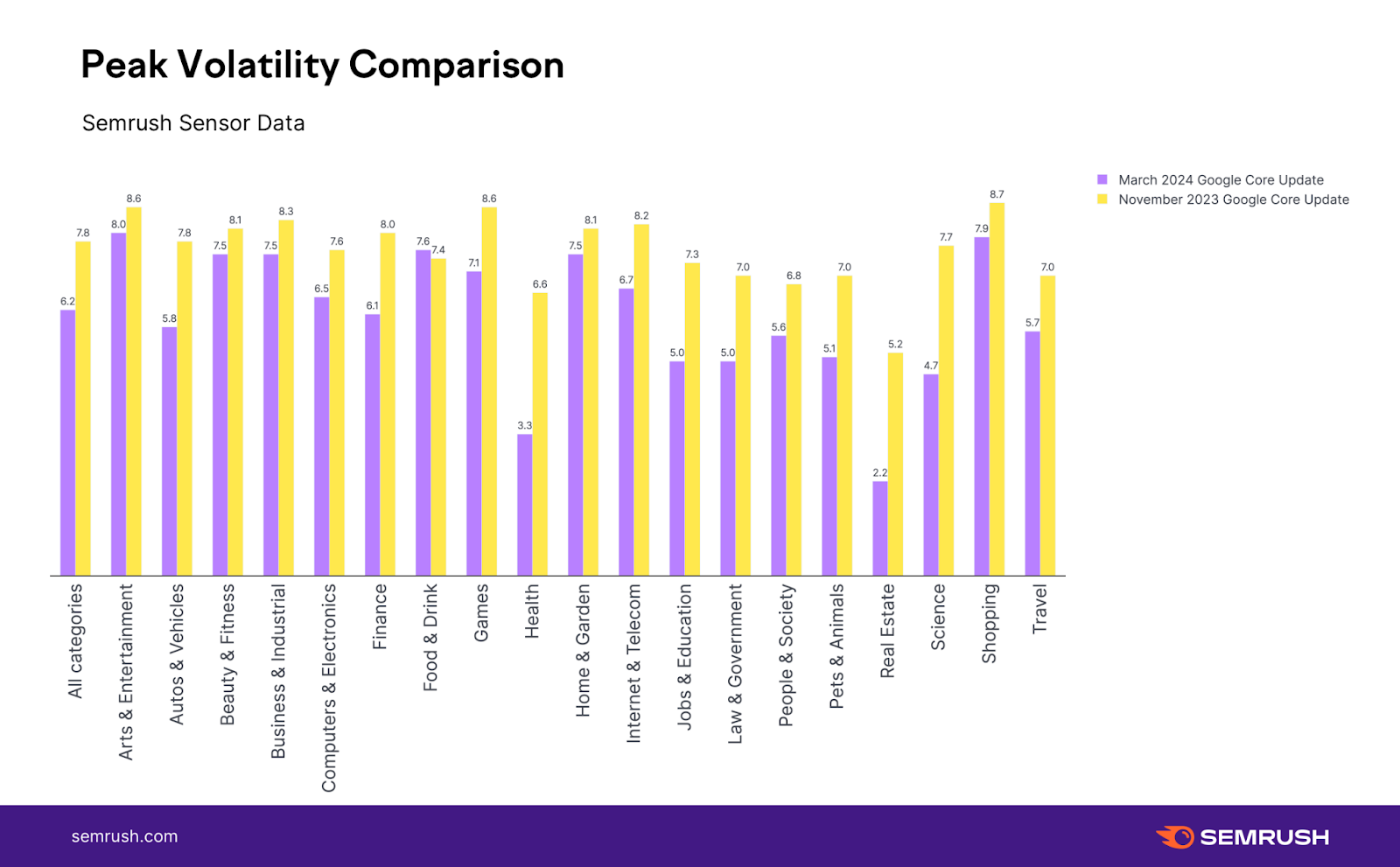
As you can see above, the amount of peak volatility seen with the November 2023 Core Update far exceeded the March 2024 Core Update across all verticals.
However, you can’t compare the peak volatility of an update that takes two weeks to roll out to one that takes 45 days. The very nature of the March 2024 Core Update was elongated. It wasn’t a quick burst of rank volatility, with maybe one to two subsequent peaks and valleys along the way.
The impact of the March 2024 Core Update wasn’t made in a burst of volatility. Rather, it was in its extended and extensive ranking shake ups over the course of 45 days. As such, peak volatility is simply the wrong metric to analyze in this situation.
Analyzing the rank volatility change has similar limitations. This data compares a point in time before the update, a point of relative volatility calm, to a specific point of increased rank volatility during an update, and measures the difference.
If we look at the rank volatility change during the March 2024 Core Update and compare it to the November 2023 Core Update, it is exactly the same, with various verticals seeing greater volatility depending on the update.
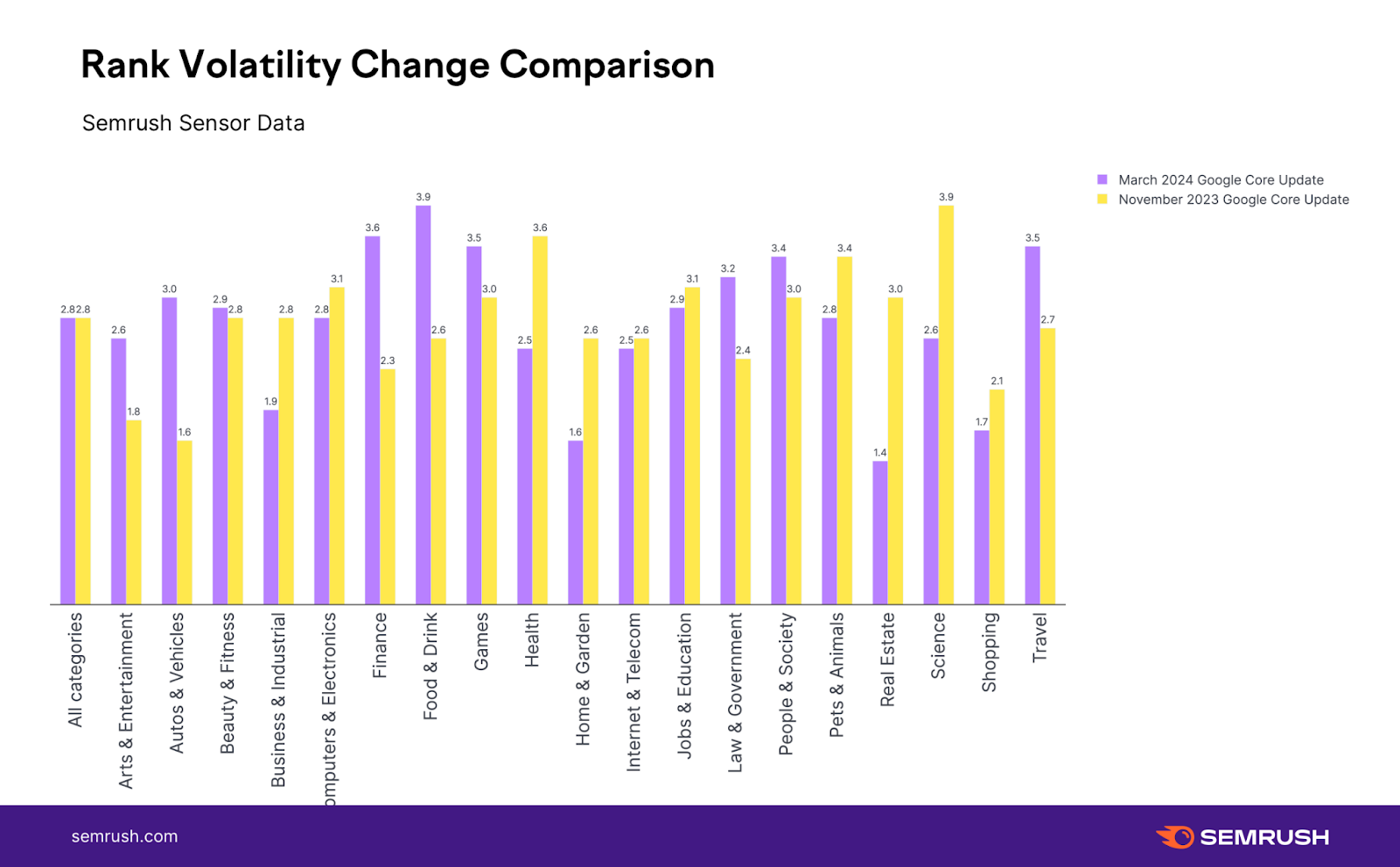
But again, looking at a specific moment in time for any update presents limitations, let alone when doing so for an update that took 45 days to roll out. Similar to relying on peak volatility, assessing the March 2024 Core Update according to volatility change, overly relies on “one moment in time” when the nature of the update was elongated.
The Nature of the Volatility
To get a better sense of the impact seen during the March 2024 Core Update, we need to better understand the nature of the rank volatility.
To start with, the average number of positions gained or lost was 2.3 positions:
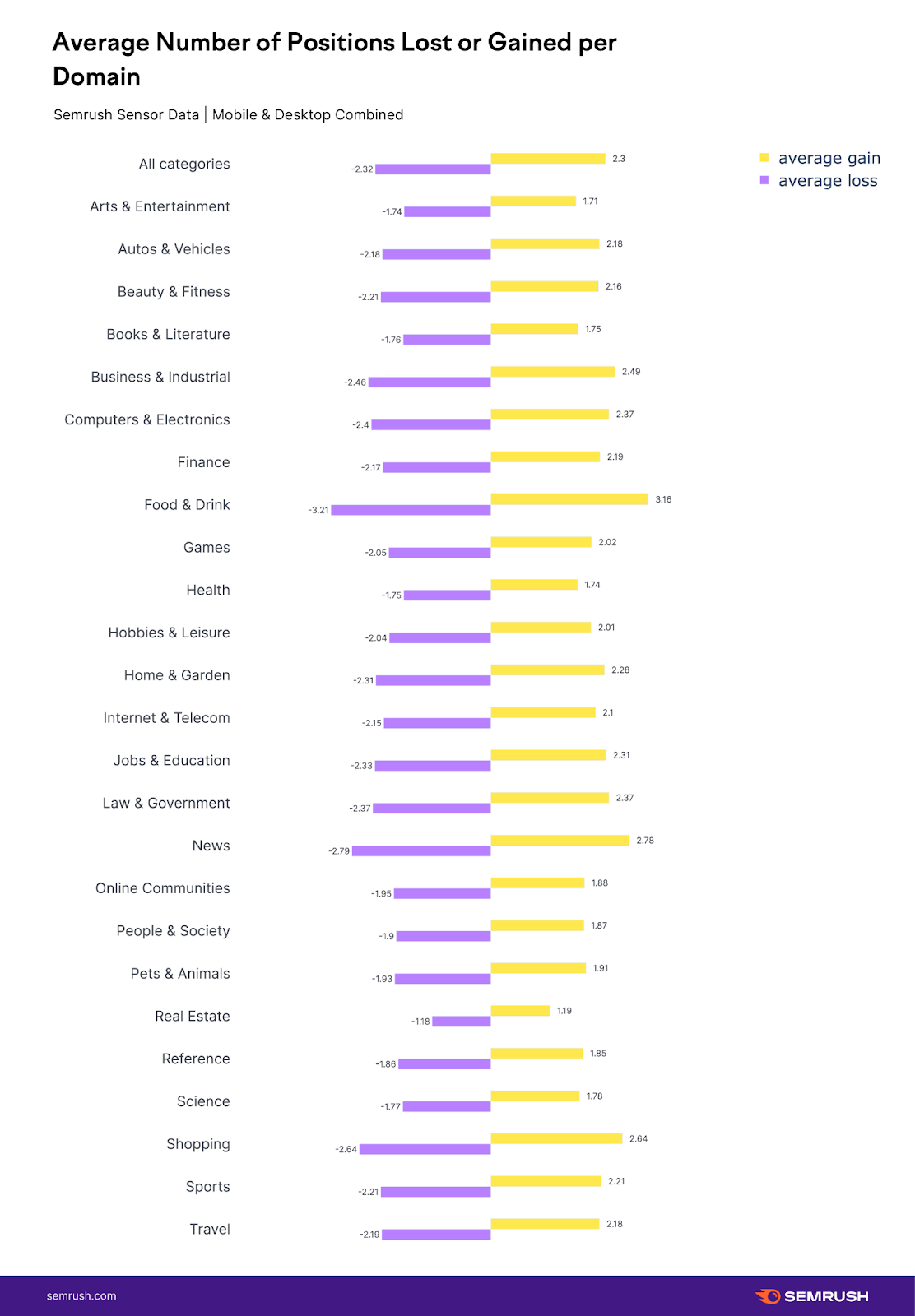
This is actually less than what was seen during the November 2023 Core Update, where the average was around 2.7 positions.
However, the average overall is very normalized across the web. Meaning, it factors in sites that saw movement and a heap of sites that were either unaffected or minimally affected.
To get a grip on the March 2024 Core Update, we need to pull back another layer of data to look at the extremity of the volatility. To do that, let’s see to what extent Google felt it was under-rewarding URLs and to what extent it rectified that.
The data below offers a general idea of just that:
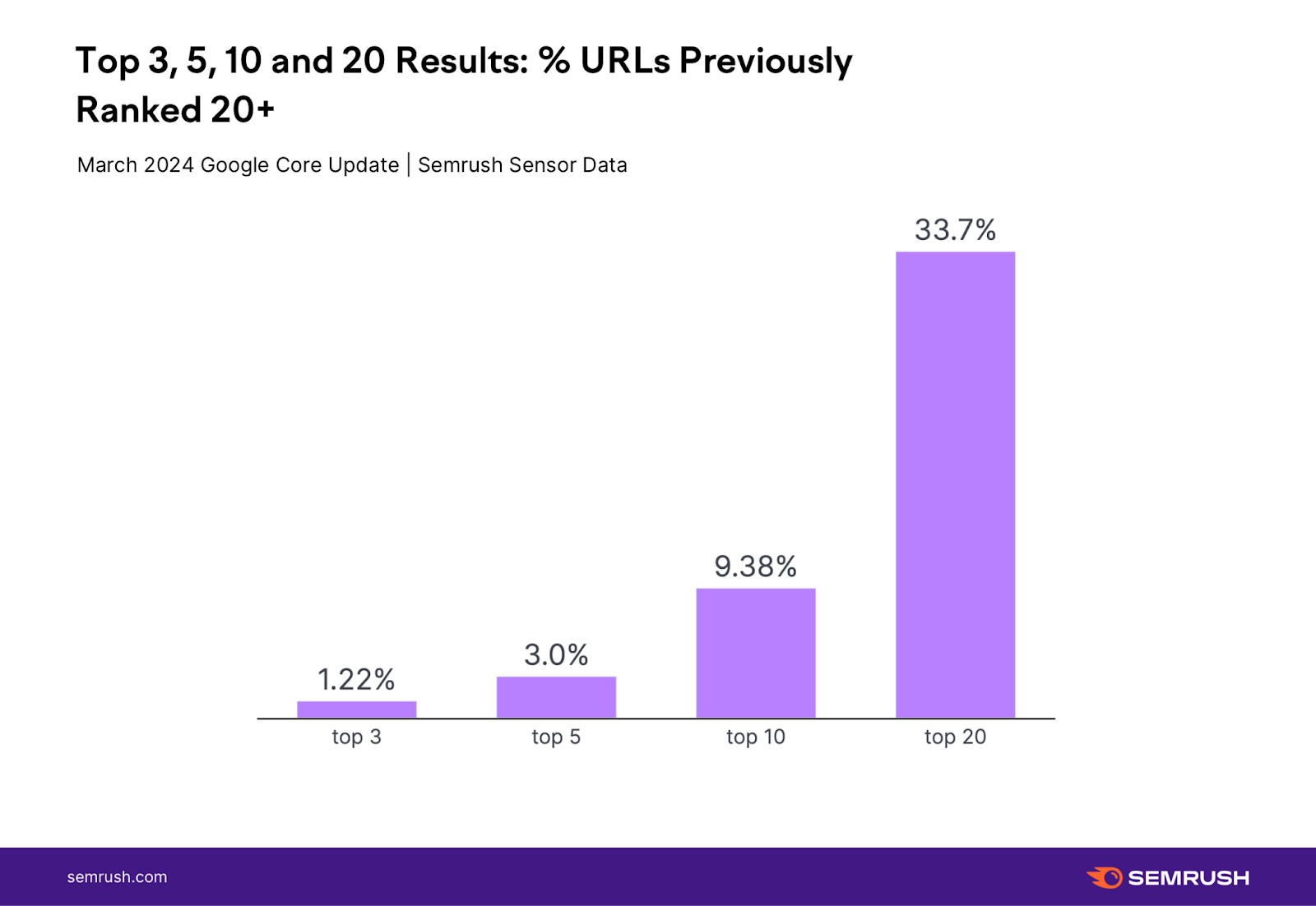
As you can see, 9.38% of the top results post-update did not even crack the top 20 prior to the March 2024 Core Update. Similarly, 3% and 1.22% of the top five and top three results respectively did not rank in the top 20 prior to the March 2024 Core Update.
Here’s our first data divergence from the November 2023 Core Update. As you can see below, there was a noticeable increase in the percentage of URLs ranking in the top 10 during the March update, that previously didn’t rank in the top 20, when compared with the November update:
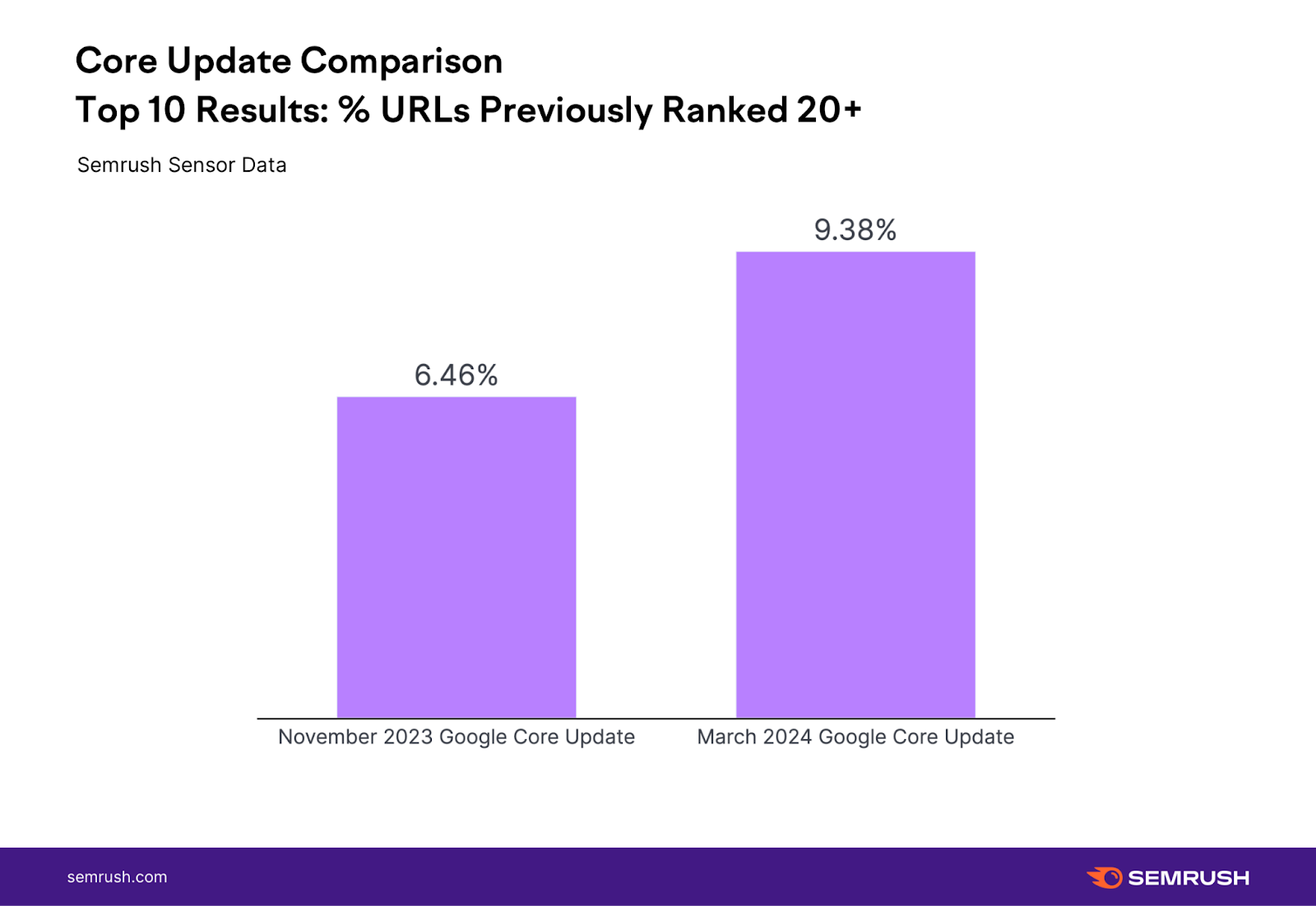
At the same time, there is not a substantial increase in this percentage when comparing the November 2023 Core Update to the March 2024 Core Update at the very top of the SERP.
As seen below, there was less than one percentage point difference:
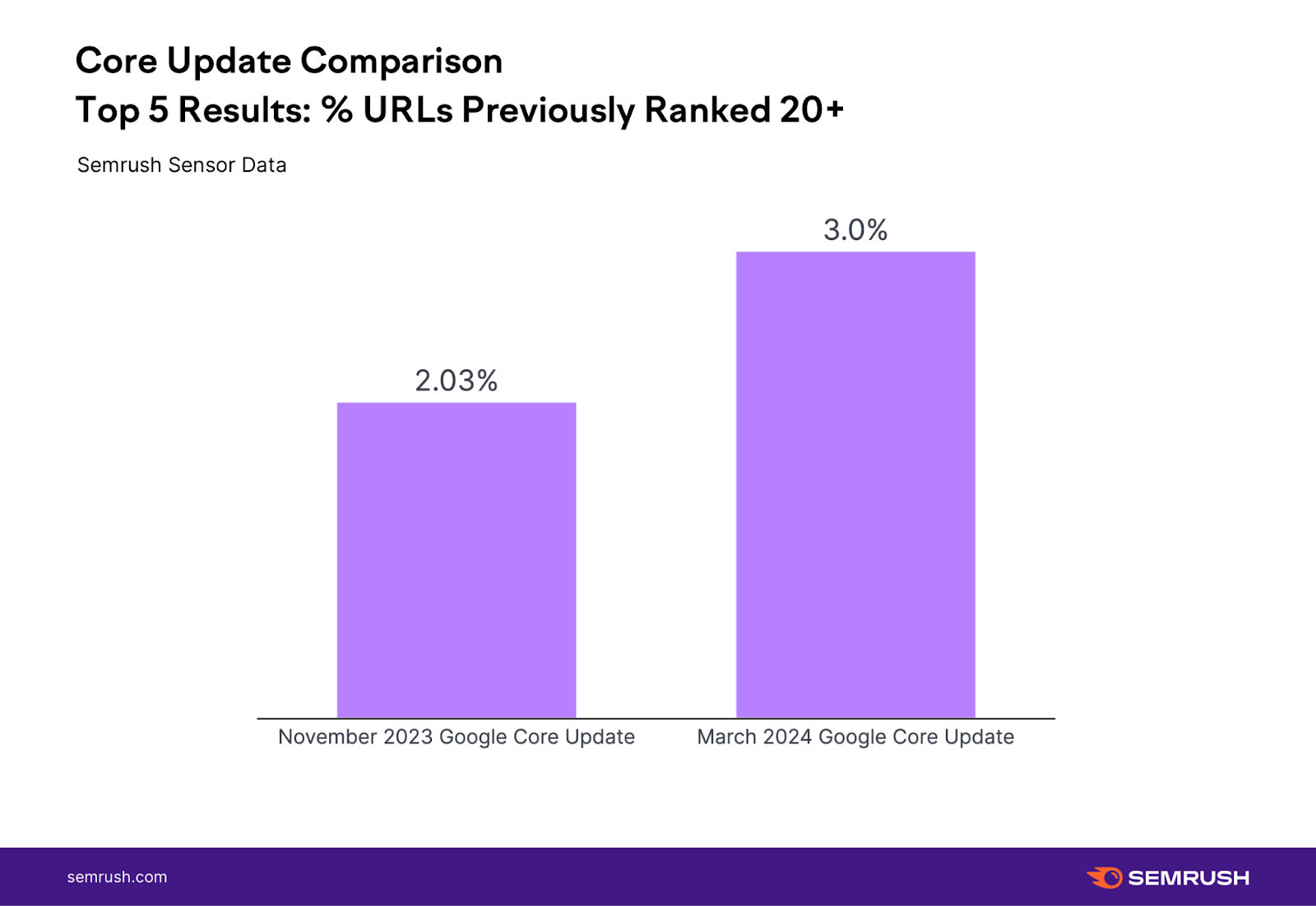
This very much aligns with my own qualitative analysis where I sifted through the ranking patterns of some 300 SERPs over the course of the update. A trend I noticed, was that there was a lot of volatility with what is often referred to as the bottom half of “page one”, whereas the top of the SERP looked very much like the example below:

The above shows a ranking pattern with minimal rank volatility over the course of the March 2024 Core Update with the top-ranking positions. This trend is confirmed by data shown earlier when comparing the November 2023 Core Update to the March 2024 Core Update. There is a substantial difference in the number of URLs ranking in the top 10, that didn’t rank in the top 20 prior to the update, but there is a far narrower difference when looking at the top five.
Parenthetically, there is a universal pattern when looking at the increase of URLs that did not rank position 20 or better prior to the update, but now rank among the top five after the March 2024 Core Update.
As indicated below, the overall 1% difference between the two updates was relatively universal across the various verticals, with just a few exceptions:
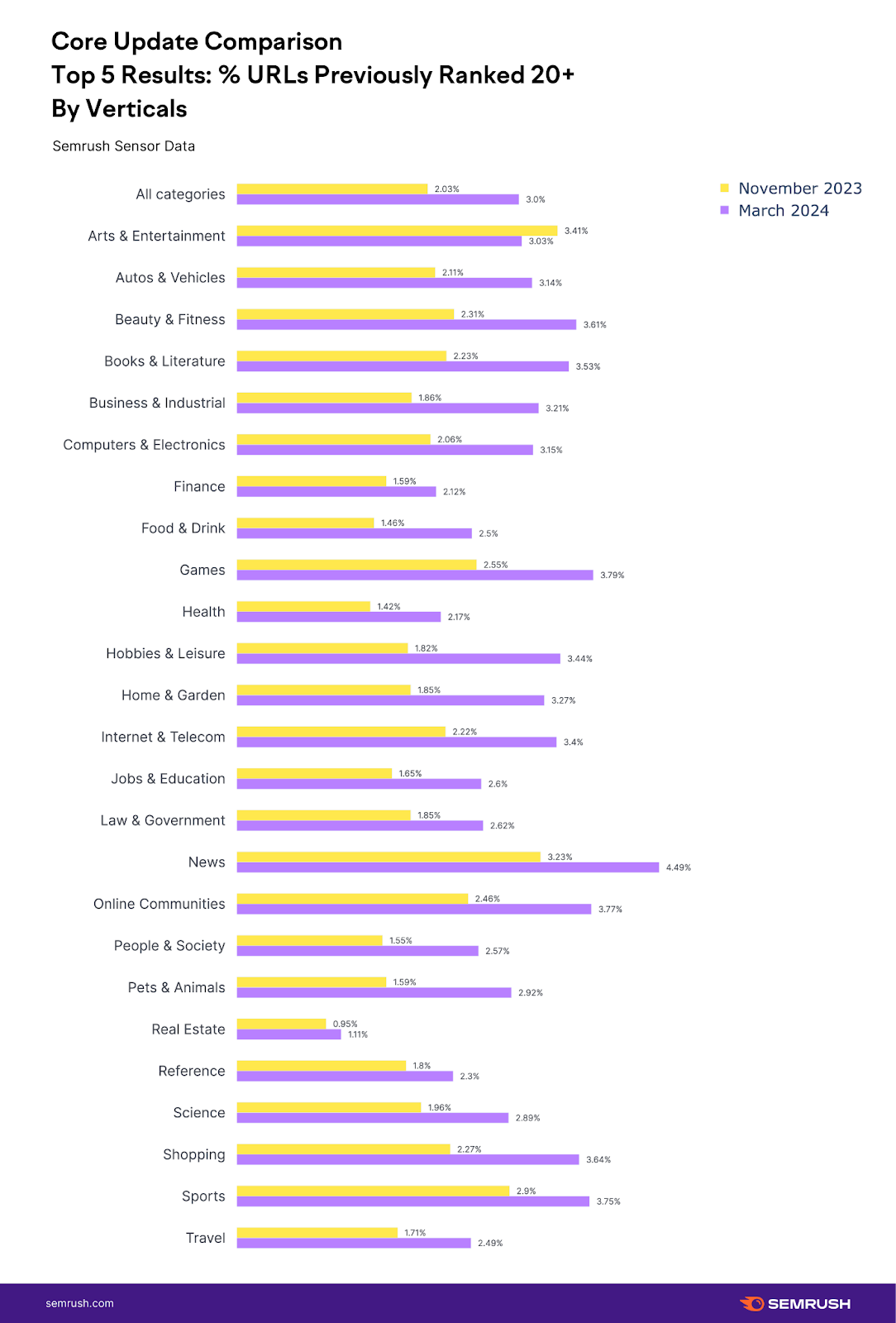
Still, looking solely at aggregate doesn’t isn’t enough to qualify the March 2024 Core Update. The data shown above, and throughout this article, needs to be combined with having your finger on the pulse of the update.
Site Level Patterns During the March 2024 Core Update
There are far too many examples to run through. So, I’ll highlight just a few cases of sites that gained or lost rankings thanks to the March 2024 Core Update. And even here, there’s another layer of analysis that needs to be done in diving into the specific keywords and the nature of the content that shifted on the SERP. However, that’s an entirely different endeavor for a different time.
One of the advantages of “helpfulness” that’s constantly assessed by the core algorithm, is that you have less chance for what Glenn Gabe refers to as dueling machine learning systems.
I believe below is such a case:

Notice how the site saw an uptick with the August 2023 Core Update, only to see a ranking decline with the September 2023 HCU.
Interestingly though with the March 2024 Core Update, we don’t see a return to what the August Core Update implemented. Rather, what we do see is a reinforcement of the ranking decrease initiated by the September 2023 HCU. In fact, I have seen numerous cases where the March 2024 Core Update simply reinforced the ranking losses of the September 2023 HCU.
Another pattern I noticed, is that some of the sites that gained rankings with the November 2023 Core Update, saw those rankings reversed with the March 2024 Core Update:
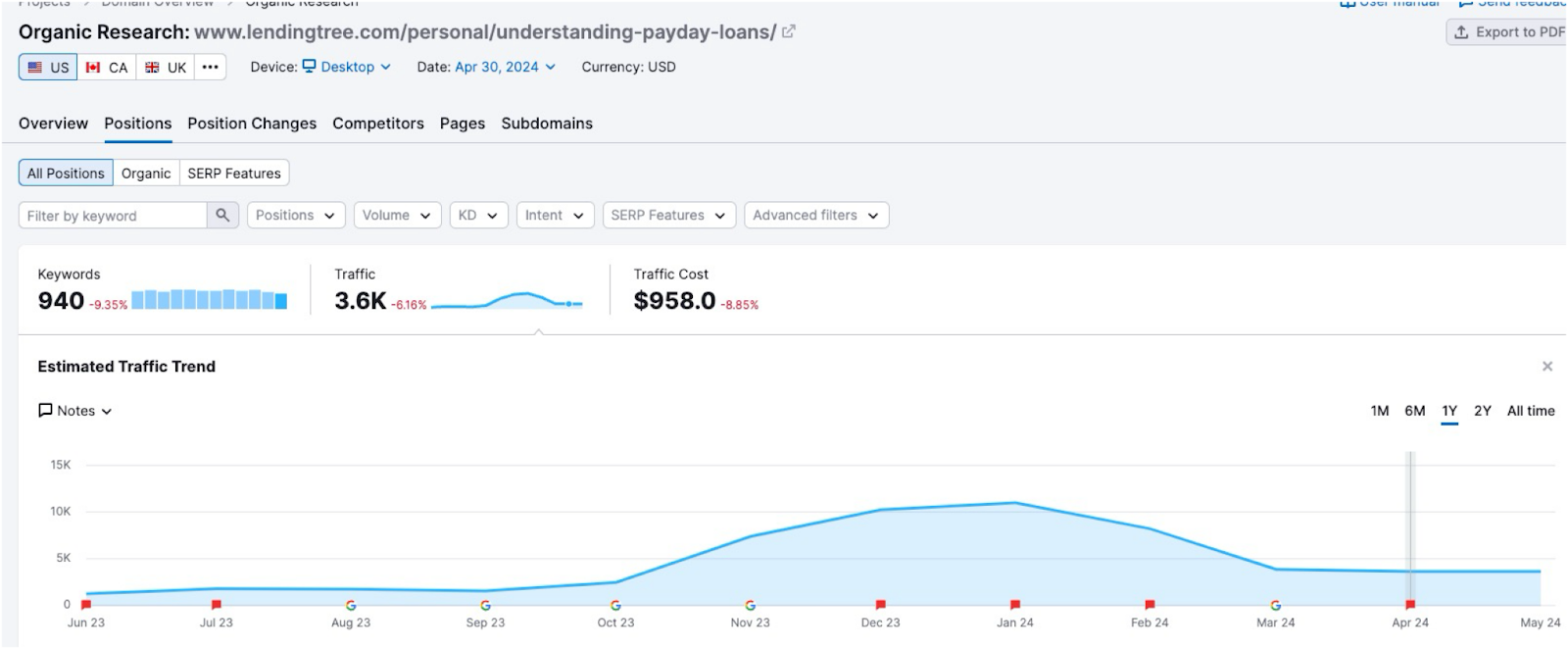
For the record, the March 2024 Core Update didn’t just demote a site’s rankings. There are many instances of very significant rank increases too.
Below is how a finance site’s informational content folder was reward with the March 2024 Core Update:

As with any core update, diving into which areas of a site were impacted can be very informative. Below is another example of Google rewarding a particular folder within a site:

You can see above just how heavy-handed, in this case in a positive way, the March 2024 Core Update was. The site here is a well-established health site that didn’t see an overall, huge improvement with the March 2024 Core Update. However, this relatively new folder seems to have “found favor” in Google’s eyes.
Lastly, as you dive into your analysis of the March 2024 Core Update, be sure to provide yourself with the proper context.
It’s easy to misinterpret the data to see either wins or losses without the proper context. Often enough there is an “algorithmic event” (i.e., an unconfirmed update) that takes place in relative proximity to the official update.
Where a site ends up, by the time an official update finishes, is often to return to its old ranking pattern.
For example, you may look at the below data and think that the URL lost rank at the hands of the March 2024 Core Update:
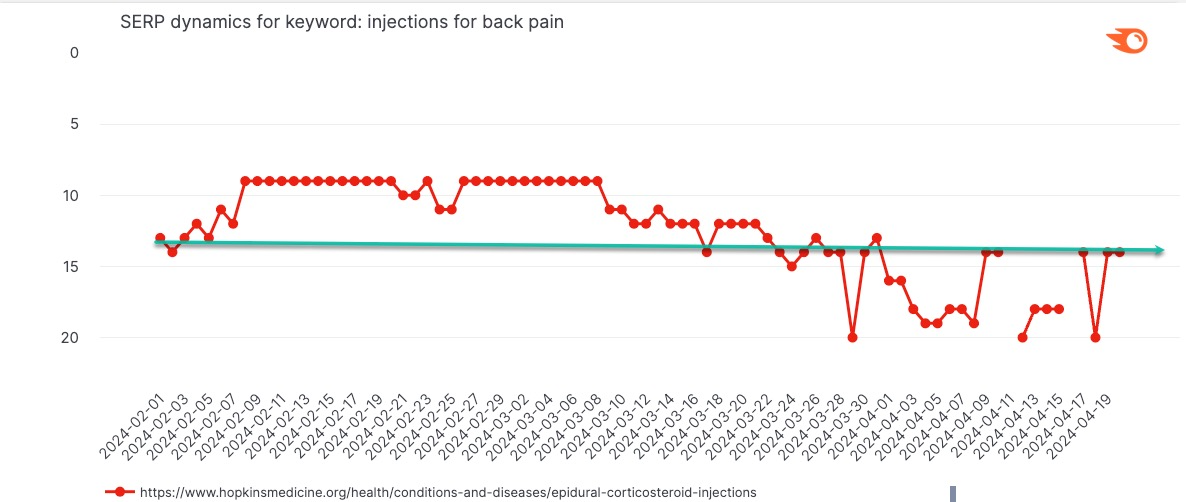
In reality, what happened is that the unconfirmed update prior to the March 2024 Core Update lifted the URL rank which was subsequently reversed. For all intents and purposes, this URL is in the same spot it was before the update.
It’s important to look at the full picture when it comes to rankings.
A Note About “45%”
Google hasn’t said much to explain what they meant by “you’ll now see 45% less low quality, unoriginal content in search results”. How much of that 45% was due to the spam updates and manual actions and how much of that was at the hands of the March 2024 Core Update? No one knows other than Google.
If you had to ask me, based on seeing the data and looking at actual sites and rankings, the March 2024 Core Update had a heavier hand than your typical core update. Did it define the SERP and usher in a new era in Google’s ability to offer helpful results? I have mixed feelings here.
To say the SERP has been defined, I would have expected more movement at the very top of the SERP as we did when looking at the bottom half of page one -see the data presented earlier. But to be fair, Google never explicitly said this was the goal.
I still think a few things need to evolve and “shake themselves out” and perhaps we’ll see that refinement with future updates.
Source link : Semrush.com
